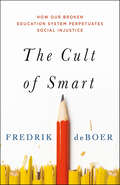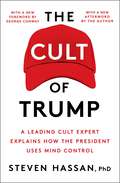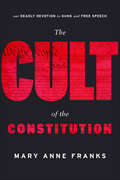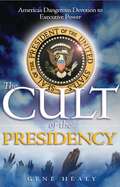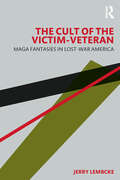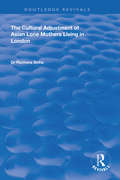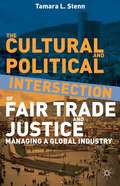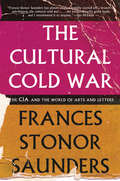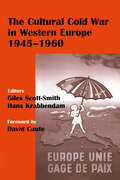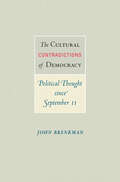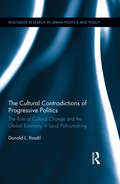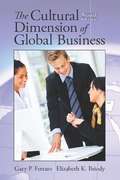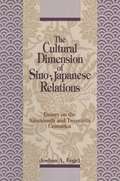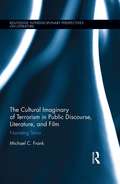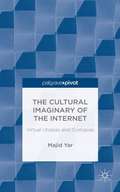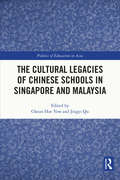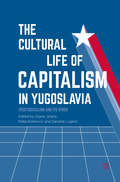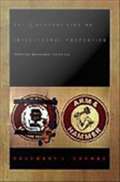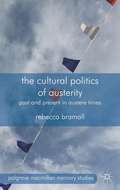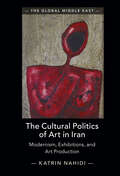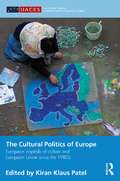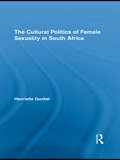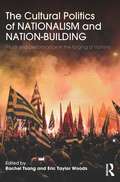- Table View
- List View
The Cult of Smart: How Our Broken Education System Perpetuates Social Injustice
by Fredrik deBoerNamed one of Vulture’s Top 10 Best Books of 2020!Leftist firebrand Fredrik deBoer exposes the lie at the heart of our educational system and demands top-to-bottom reform.Everyone agrees that education is the key to creating a more just and equal world, and that our schools are broken and failing. Proposed reforms variously target incompetent teachers, corrupt union practices, or outdated curricula, but no one acknowledges a scientifically-proven fact that we all understand intuitively: Academic potential varies between individuals, and cannot be dramatically improved. In The Cult of Smart, educator and outspoken leftist Fredrik deBoer exposes this omission as the central flaw of our entire society, which has created and perpetuated an unjust class structure based on intellectual ability.Since cognitive talent varies from person to person, our education system can never create equal opportunity for all. Instead, it teaches our children that hierarchy and competition are natural, and that human value should be based on intelligence. These ideas are counter to everything that the left believes, but until they acknowledge the existence of individual cognitive differences, progressives remain complicit in keeping the status quo in place.This passionate, voice-driven manifesto demands that we embrace a new goal for education: equality of outcomes. We must create a world that has a place for everyone, not just the academically talented. But we’ll never achieve this dream until the Cult of Smart is destroyed.
The Cult of Trump: A Leading Cult Expert Explains How the President Uses Mind Control
by Steven Hassan*As featured in the streaming documentary #UNTRUTH—now with a new foreword by George Conway and an afterword by the author* A masterful and eye-opening examination of Trump and the coercive control tactics he uses to build a fanatical devotion in his supporters written by &“an authority on breaking away from cults…an argument that…bears consideration as the next election cycle heats up&” (Kirkus Reviews). Since the 2016 election, Donald Trump&’s behavior has become both more disturbing and yet increasingly familiar. He relies on phrases like, &“fake news,&” &“build the wall,&” and continues to spread the divisive mentality of us-vs.-them. He lies constantly, has no conscience, never admits when he is wrong, and projects all of his shortcomings on to others. He has become more authoritarian, more outrageous, and yet many of his followers remain blindly devoted. Scott Adams, the creator of Dilbert and a major Trump supporter, calls him one of the most persuasive people living. His need to squash alternate information and his insistence of constant ego stroking are all characteristics of other famous leaders—cult leaders. In The Cult of Trump, mind control and licensed mental health expert Steven Hassan draws parallels between our current president and people like Jim Jones, David Koresh, Ron Hubbard, and Sun Myung Moon, arguing that this presidency is in many ways like a destructive cult. He specifically details the ways in which people are influenced through an array of social psychology methods and how they become fiercely loyal and obedient. Hassan was a former &“Moonie&” himself, and he presents a &“thoughtful and well-researched analysis of some of the most puzzling aspects of the current presidency, including the remarkable passivity of fellow Republicans [and] the gross pandering of many members of the press&” (Thomas G. Gutheil, MD and professor of psychiatry, Harvard Medical School). The Cult of Trump is an accessible and in-depth analysis of the president, showing that under the right circumstances, even sane, rational, well-adjusted people can be persuaded to believe the most outrageous ideas. &“This book is a must for anyone who wants to understand the current political climate&” (Judith Stevens-Long, PhD and author of Living Well, Dying Well).
The Cult of the Constitution: Our Deadly Devotion to Guns and Free Speech
by Mary Anne FranksIn this controversial and provocative book, Mary Anne Franks examines the thin line between constitutional fidelity and constitutional fundamentalism. The Cult of the Constitution reveals how deep fundamentalist strains in both conservative and liberal American thought keep the Constitution in the service of white male supremacy. Constitutional fundamentalists read the Constitution selectively and self-servingly. Fundamentalist interpretations of the Constitution elevate certain constitutional rights above all others, benefit the most powerful members of society, and undermine the integrity of the document as a whole. The conservative fetish for the Second Amendment (enforced by groups such as the NRA) provides an obvious example of constitutional fundamentalism; the liberal fetish for the First Amendment (enforced by groups such as the ACLU) is less obvious but no less influential. Economic and civil libertarianism have increasingly merged to produce a deregulatory, "free-market" approach to constitutional rights that achieves fullest expression in the idealization of the Internet. The worship of guns, speech, and the Internet in the name of the Constitution has blurred the boundaries between conduct and speech and between veneration and violence. But the Constitution itself contains the antidote to fundamentalism. The Cult of the Constitution lays bare the dark, antidemocratic consequences of constitutional fundamentalism and urges readers to take the Constitution seriously, not selectively.
The Cult of the Presidency: America's Dangerous Devotion to Executive Power
by Gene HealyThis book cakes a step back from the ongoing red team/blue team combat and shows that, at bottom, conservatives and liberals agree on the boundless nature of presidential responsibility. For both camps, it is the president's job to grow the economy, teach our children well, provide seamless protection from terrorist threats, and rescue Americans from spiritual malaise, very few Americans seem to think it odd, says Healy, "when presidential candidates talk as if they're running for a job that's a combination of guardian angel, shaman, and supreme warlord of the earth." <p><p> Interweaving historical scholarship, legal analysis, and trenchant cultural commentary, The Cult of the Presidency traces America's decades-long drift from the Framers' vision for the presidency: a constitutionally constrained chief magistrate charged with faithful execution of the laws. Restoring that vision will require a Congress and a Court willing to check executive power, but Healy emphasizes that there is no simple legislative or judicial "fix" to the problems of the presidency. Unless Americans change what we ask of the office - no longer demanding what we should not want and cannot have - we'll get what, in a sense, we deserve.
The Cult of the Victim-Veteran: MAGA Fantasies in Lost-war America
by Jerry LembckeThe Cult of the Victim-Veteran explores the pool of American post- Vietnam War angst that rightists began plying in the 1980s. Ronald Reagan’s 1984 proclamation of a new "Morning in America" encoded the war as the moment of the nation’s fall from grace; it was the meme plagiarized by Donald Trump for his "Make America Great Again" (MAGA) slogan. The national funk tapped for right- wing revanchism was psychologized when George H.W. Bush appropriated post- Vietnam syndrome, the diagnostic forerunner to post- traumatic stress disorder (PTSD), to memorialize the military accomplishments in the Persian Gulf War of 1990–1991—we had "kicked the Vietnam Syndrome." America was a victim- nation, its trauma emblemized by PTSD-stricken veterans whose war mission had been lost on the home front, cast aside, even spat on, upon return home. In this book we see the long historical threads woven for MAGA: the twining of traditional and modern ways of knowing that imbues war trauma with political and cultural properties that complicate its diagnostic use; the post- World War I disclosure that many shellshock patients had never been exposed to exploding shells, and the use of wounded- veteran imagery to fan the flames of German fascism; the cultural necessity of reimaging antiwar Vietnam veterans as psychiatric casualties that calls forth a new diagnostic category, PTSD; the derivatizing of PTSD for traumatic brain injury, Agent Orange, and moral injury; and the victim- veteran figure as metaphor for a wounded America, for which MAGA is the remedy.
The Cultural Adjustment of Asian Lone Mothers Living in London (Routledge Revivals)
by Rachana SinhaFirst published in 1998, this insightful volume aims to explore how 90 Indian and African single mothers in 1993 London resolve the dual challenges of single parenthood and their ethnic origins, along with a comparison with their British counterparts. This is one of only a few studies devoted exclusively to Asian lone mothers in Britain and sheds light on the problems encountered by a group largely ignored by researchers to date. Rachana Sinha establishes the impact of differences in family values on issues of marriage, women’s status and lone parenthood and brings to light some of the mothers’ cultural and psychological adjustments to these values and life in London. The women’s experiences of lone parenthood are shown through their relationships with the father, their family and friends and with contacts with social organizations. Sinha ends the study with suggestions and implications for social policy drawn from her findings.
The Cultural And Political Intersection Of Fair Trade And Justice
by Tamara L. StennThe Cultural and Political Intersection of Fair Trade and Justice is an ethnographic study of the effects of Fair Trade on indigenous women, as reported by the women themselves, and seeks to develop a deeper understanding of Fair Trade, globalization, culture, and policy in building justice.
The Cultural Cold War
by Frances Stonor SaundersDuring the Cold War, freedom of expression was vaunted as liberal democracy's most cherished possession--but such freedom was put in service of a hidden agenda. In The Cultural Cold War, Frances Stonor Saunders reveals the extraordinary efforts of a secret campaign in which some of the most vocal exponents of intellectual freedom in the West were working for or subsidized by the CIA--whether they knew it or not.Called "the most comprehensive account yet of the [CIA's] activities between 1947 and 1967" by the New York Times, the book presents shocking evidence of the CIA's undercover program of cultural interventions in Western Europe and at home, drawing together declassified documents and exclusive interviews to expose the CIA's astonishing campaign to deploy the likes of Hannah Arendt, Isaiah Berlin, Leonard Bernstein, Robert Lowell, George Orwell, and Jackson Pollock as weapons in the Cold War. Translated into ten languages, this classic work--now with a new preface by the author--is "a real contribution to popular understanding of the postwar period" (The Wall Street Journal), and its story of covert cultural efforts to win hearts and minds continues to be relevant today.
The Cultural Cold War in Western Europe, 1945-60 (Studies in Intelligence)
by Giles Scott-Smith Hans KrabbendamThe idea of the Cold War as a propaganda contest as opposed to a military conflict is being increasingly accepted. This has led to a re-evaluation of the relationship between economic policies, political agendas and cultural activities in Western Europe post 1945.This book provides an important cross-section of case studies that highlight the connections between overt/covert activities and cultural/political agendas during the early Cold War. It therefore provides a valuable bridge between diplomatic and intelligence research and represents an important contribution towards our understanding of the significance and consequences of this linkage for the shaping of post-war democratic societies.
The Cultural Contradictions of Democracy: Political Thought since September 11
by John BrenkmanSince 9/11, American foreign policy has been guided by grand ideas like tyranny, democracy, and freedom. And yet the course of events has played havoc with the cherished assumptions of hawks and doves alike. The geo-civil war afflicting the Muslim world from Lebanon through Iraq and Afghanistan to Pakistan confronts the West with the need to articulate anew what its political ideas and ideals actually are. In The Cultural Contradictions of Democracy, John Brenkman dissects the rhetoric that has corrupted today's political discourse and abused the idea of freedom and democracy in foreign affairs. Looking back to the original assumptions and contradictions that animate democratic thought, he attempts to resuscitate the language of liberty and give political debate a fresh basis amid the present global turmoil. The Cultural Contradictions of Democracy picks apart the intellectual design and messianic ambitions of the neoconservative American foreign policy articulated by figures such as Robert Kagan and Paul Berman; it casts the same critical eye on a wide range of liberal and leftist thinkers, including Noam Chomsky and Jürgen Habermas, and probes the severe crisis that afflicts progressive political thought. Brenkman draws on the contrary visions of Hobbes, Kant, Max Weber, Hannah Arendt, and Isaiah Berlin in order to disclose the new contours of conflict in the age of geo-civil war, and to illuminate the challenges and risks of contemporary democracy.
The Cultural Contradictions of Progressive Politics: The Role of Cultural Change and the Global Economy in Local Policymaking (Routledge Research in Urban Politics and Policy)
by Donald L. RosdilWhy do some U.S. cities like Seattle and Boston impose social exactions and sustainability targets on private investment while others like Las Vegas and Houston offer property tax and fee remissions to business, tolerate environmentally hazardous activities such as oil drilling, and express skepticism even about recycling mandates? The behavior of the former cities appears especially puzzling in view of globalization processes that seemingly offer many more options to mobile capital and expose cities’ vulnerability to private investment decisions. Cultural Contradictions examines the paradoxical finding that some U.S. cities can impose burdensome regulations and extract social and environmental contributions from the private sector despite an apparently weak bargaining position. It usescultural change and the growth of non-traditional subcultures to explain why cities adopt these progressive policies. Responding to the urban policy literature’s tendency to prioritize economic considerations over other kinds of causal factors, the book demonstrates the joint impact of culture and economics in encouraging policy outcomes which emphasize social justice, human rights, and environmental sustainability in large U.S. cities. The book makes several specific contributions to urban literature. First, it argues that cities in which nontraditional cultural beliefs and practices thrive and which are strongly linked to dynamic economic sectors such as information services, professional, scientific and technical services, financial services, and education and health care services are especially likely to adopt progressive policies. It establishes this claim using both statistical analysis of large-N city samples and a closer investigation of four case studies. Second, it reveals how progressive policies are a plausible response to psychological concerns associated with unconventional ways of life and the nature of postindustrial society. Finally, the book indicates how these new ways of life and postindustrial economic sectors grow in mutually reinforcing ways in order to make these policies acceptable to local economic elites and therefore favorable to the city’s future development.
The Cultural Dimension of Global Business 7th Edition
by Gary P. Ferraro Elizabeth K. BriodyThe Cultural Dimension of Global Business provides a foundation for understanding the impact of culture on global business and global business on culture.
The Cultural Dimensions of Sino-Japanese Relations: Essays on the Nineteenth and Twentieth Centuries
by Joshua A. FogelPresents the perceptions that the Chinese and the Japanese have of each other, and the information that helped to fuel those perceptions. There are two sections: China in Japan, debating the Asiatic Mode of Production and kyodotai; and Japan in China, covering the Manchurian Railway.
The Cultural Imaginary of Terrorism in Public Discourse, Literature, and Film: Narrating Terror (Routledge Interdisciplinary Perspectives on Literature)
by Michael C. FrankThis study investigates the overlaps between political discourse and literary and cinematic fiction, arguing that both are informed by, and contribute to, the cultural imaginary of terrorism. Whenever mass-mediated acts of terrorism occur, they tend to trigger a proliferation of threat scenarios not only in the realm of literature and film but also in the statements of policymakers, security experts, and journalists. In the process, the discursive boundary between the factual and the speculative can become difficult to discern. To elucidate this phenomenon, this book proposes that terror is a halfway house between the real and the imaginary. For what characterizes terrorism is less the single act of violence than it is the fact that this act is perceived to be the beginning, or part, of a potential series, and that further acts are expected to occur. As turn-of-the-century writers such as Stevenson and Conrad were the first to point out, this gives terror a fantastical dimension, a fact reinforced by the clandestine nature of both terrorist and counter-terrorist operations. Supported by contextual readings of selected texts and films from The Dynamiter and The Secret Agent through late-Victorian science fiction to post-9/11 novels and cinema, this study explores the complex interplay between actual incidents of political violence, the surrounding discourse, and fictional engagement with the issue to show how terrorism becomes an object of fantasy. Drawing on research from a variety of disciplines, The Cultural Imaginary of Terrorism will be a valuable resource for those with interests in the areas of Literature and Film, Terrorism Studies, Peace and Conflict Studies, Trauma Studies, and Cultural Studies.
The Cultural Imaginary of the Internet: Virtual Utopias and Dystopias
by Majid YarContemporary culture offer contradictory views of the internet and new media technologies, painting them in extremes of optimistic enthusiasm and pessimistic concern. This book explores such representations, uncovering the roots of our cultural responses to the internet, centred upon a profoundly ambivalent reaction to technological modernity.
The Cultural Legacies of Chinese Schools in Singapore and Malaysia (Politics of Education in Asia)
by Cheun Hoe Yow Jingyi QuThis edited volume examines the historical development of Chinese-medium schools from the British colonial era to recent decades of divergent development after the 1965 separation of Singapore and Malaysia. Educational institutions have been a crucial state apparatus in shaping the cultural identity and ideology of ethnic Chinese in Singapore and Malaysia. This volume applies various perspectives from education theory to heritage studies in dealing with the cultural legacy and memory of such schools as situated in larger contexts of society. The book offers comprehensive practice-based analysis and reflection about the complex relationships between language acquisition, identity construction, and state formation from socio-political-cultural perspectives. It covers a broad range of aspects from identities of culture, gender, and religion, to the roles played by the state and the community in various aspects of education such as textbooks, cultural activities, and adult education, as well as the representation of culture in Chinese schools through cultural memory and literature. The readership includes academics, students and members of the public interested in the history and society of the Chinese diaspora, especially in South East Asia. This also appeals to scholars interested in a bilingual or multilingual outlook in education as well as diasporic studies.
The Cultural Life of Capitalism in Yugoslavia
by Dijana Jelača Maša Kolanović Danijela LugarićThis edited volume explores the cultural life of capitalism during socialist and post-socialist times within the geopolitical context of the former Yugoslavia. Through a variety of cutting edge essays at the intersections of critical cultural studies, material culture, visual culture, neo-Marxist theories and situated critiques of neoliberalism, the volume rethinks the relationship between capitalism and socialism. Rather than treating capitalism and socialism as mutually exclusive systems of political, social and economic order, the volume puts forth the idea that in the context of the former Yugoslavia, they are marked by a mutually intertwined existence not only on the economic level, but also on the level of cultural production and consumption. It argues that culture--although very often treated as secondary in the analyses of either socialism, capitalism or their relationship--has an important role in defining, negotiating, and resisting the social, political and economic values of both systems.
The Cultural Life of Intellectual Properties: Authorship, Appropriation, and the Law
by Rosemary J. CoombeLogos, trademarks, national insignia, brand names, celebrity images, design patents, and advertising texts are vibrant signs in a consumer culture governed by a regime of intellectual property laws. In The Cultural Life of Intellectual Properties, professor of law and cultural anthropologist Rosemary J. Coombe brings an illuminating ethnographic approach to an analysis of authorship and the role law plays in shaping the various meanings that animate these protected properties in the public sphere. Although such artifacts are ubiquitous in contemporary culture, little attention has been paid to the impact of intellectual property law in everyday life or to how ownership of specific intellectual properties is determined and exercised. Drawing on a wide range of cases, disputes, and local struggles, Coombe examines these issues and dismantles the legal assumption that the meaning and value of a text or image is produced exclusively by an individual author or that authorship has a single point of origin. In the process, she examines controversies that include the service of turbanned Sikhs in the Royal Canadian Mounted Police and the use of the term Olympic in reference to the proposed gay Olympic Games. Other chapters discuss the appropriation of such celebrity images as the Marx brothers, Judy Garland, Dolly Parton, James Dean, and Luke Skywalker; the conflict over team names such as the Washington Redskins; and the opposition of indigenous peoples to stereotypical Native American insignia proffered by the entertainment industry. Ultimately, she makes a case for redefining the political in commodified cultural environments. Significant for its insights into the political significance of current intellectual property law, this book also provides new perspectives on debates in cultural anthropology, cultural studies, and political theory. It will therefore interest both a wide scholarly and a general audience.
The Cultural Logic of Computation
by David GolumbiaAdvocates of computers make sweeping claims for their inherently transformative power: new and different from previous technologies, they are sure to resolve many of our existing social problems, and perhaps even to cause a positive political revolution. In The Cultural Logic of Computation, David Golumbia, who worked as a software designer for more than ten years, confronts this orthodoxy, arguing instead that computers are cultural “all the way down”—that there is no part of the apparent technological transformation that is not shaped by historical and cultural processes, or that escapes existing cultural politics. From the perspective of transnational corporations and governments, computers benefit existing power much more fully than they provide means to distribute or contest it. Despite this, our thinking about computers has developed into a nearly invisible ideology Golumbia dubs “computationalism”—an ideology that informs our thinking not just about computers, but about economic and social trends as sweeping as globalization. Driven by a programmer’s knowledge of computers as well as by a deep engagement with contemporary literary and cultural studies and poststructuralist theory, The Cultural Logic of Computation provides a needed corrective to the uncritical enthusiasm for computers common today in many parts of our culture.
The Cultural Logic of Politics in Mainland China and Taiwan
by Tianjian ShiTianjian Shi shows how cultural norms affect political attitudes and behavior through two causal pathways, one at the individual level and one at the community level. Focusing on two key norms - definition of self-interest and orientation to authority - he tests the theory with multiple surveys conducted in mainland China and Taiwan. Shi employs multi-level statistical analysis to show how, in these two very different political systems, similar norms exert similar kinds of influence on political trust, understanding of democracy, forms of political participation, and tolerance for protest. The approach helps to explain the resilience of authoritarian politics in China and the dissatisfaction of many Taiwan residents with democratic institutions. Aiming to place the study of political culture on a new theoretical and methodological foundation, Shi argues that a truly comparative social science must understand how culturally embedded norms influence decision making.
The Cultural Politics Of Austerity
by Rebecca BramallThis timely book examines austerity's conflicted meanings, from austerity chic and anti-austerity protest to economic and eco-austerity. Bramall's compelling text explores the presence and persuasiveness of the past, developing a new approach to the historical in contemporary cultural politics.
The Cultural Politics of Art in Iran: Modernism, Exhibitions, and Art Production (The Global Middle East)
by Katrin NahidiModernist Iranian art represents a highly diverse field of cultural production deeply involved in discussing questions of modernity and modernization as practiced in Iran. This book investigates how artistic production and art criticism reflected upon the discourse about gharbzadegi (westoxification), the most substantial critique of Iran's adaptation of Western modernity, and ultimately proved to be a laboratory for the negotiation of an anti-colonial concept of an Iranian artistic modernity, which artists and critics envisioned as a significant other to Western colonial modernity. In this book, Katrin Nahidi revisits Iranian modernist art, aiming to explore a political and contextualized interpretation of modernism. Based on extensive fieldwork, interviews, and archival research, Nahidi provides a history of modernist art production since the 1950s and reveals the complex political agency underlying art historiographical processes. Offering a key contribution to postcolonial art history, Nahidi shows how Iranian artistic modernity was used to flesh out anti-colonial concepts and ideas around Iranian national identity.
The Cultural Politics of Europe: European Capitals of Culture and European Union since the 1980s (Routledge/UACES Contemporary European Studies)
by Kiran Klaus PatelCulture is one of the most complex and contested fields of European integration. This book analyzes EU cultural politics since their emergence in the 1980s with a particular focus on the European Capital of Culture program, the flagship of EU cultural policy. It discusses both the central as well as local levels and contextualizes EU policies with programmes of other European organisations, such as the Council of Europe. By asking what "Europe" actually means for European cultural policy, the book goes beyond the confines of official organizations and the political sphere, to discuss the contribution, impact and appropriation among a more diverse group of actors and participants, such as transnational experts, local bureaucrats, cultural managers, urban dwellers and the visitors. Its principal aim is to debunk the myth of Brussels as the centre of cultural Europeanization. Instead, it argues that European cultural policy has to be seen as a relational, multi-directional movement, involving a wide variety of stakeholders and leading to conflicts and collaborations at various levels. This book combines the perspectives of political scientists, sociologists, anthropologists and historians, at the intersection between EU, urban, and cultural studies, and changes our understanding of ‘Europeanization’ by opening up new empirical and conceptual avenues. Challenging the dominant interpretation of European cultural policies, The Cultural Politics of Europe will be of interest to students and scholars of European studies, political scientists, sociologists, anthropologists, geographers, historians and cultural studies.
The Cultural Politics of Female Sexuality in South Africa (Routledge Research in Gender and Society)
by Henriette GunkelSexual identity has emerged into the national discourse of post-apartheid South Africa, bringing the subject of rights and the question of gender relations and cultural authenticity into the focus of the nation state’s politics. This book is a fascinating reflection on the effects of these discourses on non-normative modes of sexuality and intimacy and on the country more generally. While in 1996, South Africa became the first country in the world that explicitly incorporated lesbian and gay rights within a Bill of Rights, much of the country has continued to see homosexuality as un-African. Henriette Gunkel examines how colonialism and apartheid have historically shaped constructions of gender and sexuality and how these concepts have not only been re-introduced and shaped by understandings of homosexuality as un-African but also by the post-apartheid constitution and continued discourse within the nation.
The Cultural Politics of Nationalism and Nation-Building: Ritual and performance in the forging of nations
by Eric Taylor Woods Rachel TsangRituals and performances are a key theme in the study of nations and nationalism. With the aim of stimulating further research in this area, this book explores, debates and evaluates the role of rituals and performances in the emergence, persistence and transformation of nations, nationalisms and national identity. The chapters comprising this book investigate a diverse array of contemporary and historical phenomena relating to the symbolic life of nations, from the Yasukuni Shrine in Japan to the Louvre in France, written by an interdisciplinary cast of world-renowned and up-and-coming scholars. Each of the contributors has been encouraged to think about how his or her particular approach and methods relates to the others. This has given rise to several recurring debates and themes running through the book over how researchers ought to approach rituals and performances and how they might best be studied. The Cultural Politics of Nationalism and Nation-Building will appeal to students and scholars of ethnicity and nationalism, sociology, political science, anthropology, cultural studies, performance studies, art history and architecture.
